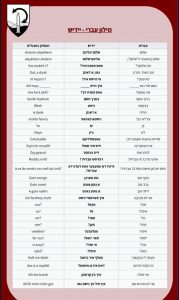 As the African proverb says “The foundations of what must last are never based on the present”
As the African proverb says “The foundations of what must last are never based on the present”
FJN has for several years been asking the various successive Israeli education ministers to reintegrate Yiddish into the school curriculum, each time coming up against an almost systematic refusal. Suddenly, during COVID-19, we saw the Israeli security forces distributing a Hebrew / Yiddish dictionary in the ultra-Orthodox neighborhood of Mea Shearim in Jerusalem, March 30, 2020, as part of the efforts to curb the spread of the Covid-19 coronavirus pandemic. Unfortunately we would have had to wait dramatic circumstances to remember the necessity. Nothing trivial about that. Often equated with jargon without a future, this is an established finding among a whole generation of Israelis : Yiddish remains the assimilated language, linked to the historical context of the Shoah thus retaining an almost disturbing character.
But how can confidence be restored and the Yiddish residents be reassured? The Government also handed over to each IDF soldier on mission to Bne-Brak or another city and ultra-Orthodox district of the country to enforce containment and manage logistics received this same Hebrew / Yiddish lexicon. A wise idea that allows them to approach the inhabitants in a familiar language. Yiddish is often presented as an endangered language. She suffers from a negative vision, conveyed by non-Yiddishist society which sees in its use a brake on assimilation of Jews in Israeli society. And yet Tens of thousands of “yid” still speak it, notably devotees who do not want to profane the holy language. It’s their choice. Often equated with jargon with no future these days, Yiddish has a special place in Jewish culture Yiddish has evolved considerably, and retains its genius and expressive force. African Jews will speak Yiddish.
A dank, zayt gesunt
